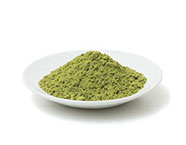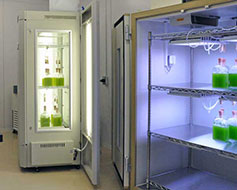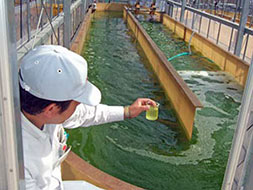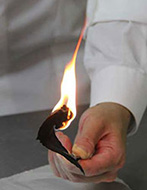Web Japan > Trends in Japan > Tech & Life > Grow algae & change the world
Grow algae & change the world
Developing a New Resource
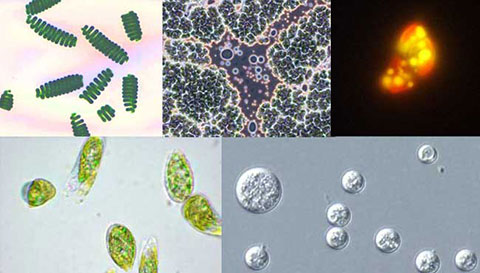
Upper Left: Spirulina is popular world-wide as a natural blue dye and a dietary supplement (Photo courtesy of DIC Corporation. Upper Center: "Enomoto Algae" an improved strain of Botryococcus that multiplies at a rapid speed (Photo courtesy of IHI NeoG Algae LLC). Upper Right: Pseudochoricystis Ellipsoidea stores oil similar in quality to light oil, using photosynthesis (Photo courtesy of DENSO Corporation.) Lower Left: Euglena can move around like an animal (Photo courtesy of euglena Co., Ltd.) Lower Right: Aurantiochytrium is not photosynthetic, but multiplies by ingesting organic matter; the speed at which it multiplies is its characteristic feature. (Photo courtesy of University of Tsukuba.)
The spotlight is on research into the cultivation of algae that live in lakes and at the seaside, amid concerns over depleting energy resources such as oil, and food crises caused by the population explosion. Some algae feature the ability to reproduce easily and are rich in nutrients; and there are even types that produce an oily substance similar to petroleum oil. The cultivation of these types of algae produces high yields per unit of growing area in comparison with land-based plants; and another big attraction is that the photosynthetic varieties can also be used to help combat global warming. Attention is focused on initiatives promoted by Japanese companies and research institutes that aim to develop algae as a resource.
Spirulina – “Food of the Future”
In 1981 a group of Japanese chemical manufacturers began the artificial cultivation of the microalgae "Spirulina" in the deserts of California, USA, where strong sunlight blazes down. The group produces 500 tons of edible algae a year in the world's largest cultivation ponds for outdoor plants, measuring 180,000 square meters in total area. Together with the plant established on Hainan Island, China in 1997 (which has a total area of 100,000 square meters), the group produces 850 tons of Spirulina a year and is known for being the world's number one supplier, supplying products to 30 countries etc.
Spirulina is often used in chewing gum and ice-cream for its natural blue pigment and in tablet form for dietary supplements, and it is expected to be a "food of the future", as it contains over 50 healthy nutrients, including vitamins, minerals and amino acids. At the same time, it also has the potential to reduce greenhouse gases. It evolved on earth more than 3 billion years ago and brought the first oxygen to the planet; indeed such is its power of photosynthesis that the Japan Aerospace Exploration Agency (JAXA) has introduced it into air purification system R&D for the space station.
It May Even be Used for Jet Fuel!?
Left: Powder made from Euglena harvested on Ishigaki Island in Okinawa Prefecture. (Photo courtesy of euglena Co., Ltd.)
Right: A "Euglena Farm Vehicle" that runs on a blend of diesel and oil extracted from Euglena. (Photo courtesy of euglena Co., Ltd.)
There estimated to be some 300,000 - 10 million species of algae living on earth. Of these there are some varieties with chloroplasts from several microns to several tens of microns in their cells that photosynthesize like plants; and others that can move around like animals. Interest is rapidly growing in "Euglena" - microalgae that combine both of these properties and are also able to produce oil as a raw material. In 2005, a bio-venture company from the University of Tokyo became the first in the world to successfully mass-cultivate Euglena outdoors. The company has promoted the spread of Euglena by manufacturing dietary supplements that utilize its 59 nutrients; meanwhile it aims to develop and commercialize it for use as jet fuel by around 2018.
The oil made from the purified oily substance produced by Euglena is known to be very similar to jet fuel; being extremely light and high grade. Another major advantage in terms of mass production is that Euglena is not covered by cell walls like common algae, making it easy to extract the oily substance.
New Energy from Domestic Wastewater
There is even a project for a recycling system underway where microalgae are introduced into a sewerage treatment facility to produce oil that is then used in the facility's incinerator. In 2012, the city of Sendai joined forces with University of Tsukuba and Tohoku University in a joint project where 2 types of algae, including a heterotrophic "Aurantiochytrium", would be introduced into the production of hydrocarbons (oils). The plan is to install an outdoor pilot plant at Sendai's sewerage treatment facility in 2015 and start the following year.
Aurantiochytrium is not photosynthetic, but it uptakes in organic matters from the sewage sludge and converts them to oils. It multiplies by fission in 2-4 hours and this multiplication rate is much faster than that of photosynthetic organisms. Another algae "Botryococcus braunii" it is possible to produce oils by photosynthesis, it utilizes the inorganic nitrogen and phosphate remaining in the treated sewage water as nutrients; and also the heat and carbon dioxide that are discharged from the incinerator can be effectively utilized. Combining these mechanisms will complete a revolutionary recycling system that can produce new energy from domestic wastewater.
Putting Biofuel to Practical Use
Left: Empirical experiments using a 350 square meter cultivation tank (Photo courtesy of DENSO Corporation)
Right: “Enomoto Algae" - an improved strain of Botryococcus – is dried and being ignited (Photo courtesy of IHI NeoG Algae LLC).
A leading car parts manufacturer is also developing a recycling system that uses in its factory the oil produced by algae-photosynthesis of the carbon dioxide emitted from the factory. This manufacturer is aiming to mass produce Pseudochoricystis ellipsoidea, which can produce oil similar to light oil using photosynthesis. The project is also developing new technology using the microwaves found in microwave ovens, to efficiently convert the oil to biofuel.
The biggest challenge in the commercialization of biofuels is to reduce production costs. One of the most effective means to improve the production efficiency of algae is to develop improved strains. A bio-venture company, funded by a leading Japanese manufacturer of general heavy machinery, is aiming to commercialize the "Enomoto algae" which is an improved strain of Botryococcus that multiplies at around 1000 times the speed of the traditional variety. Even if their density in the plant increases, production volumes will not fall with this improved strain; and the fact that it is resistant to unwanted bacteria and so can be cultivated outdoors, means that equipment costs are likely to be significantly reduced.
Algae biofuel still seemed like a pipe dream a few years ago, but these studies into practical uses seem to be gradually increasing in pace.
(November 2013)

